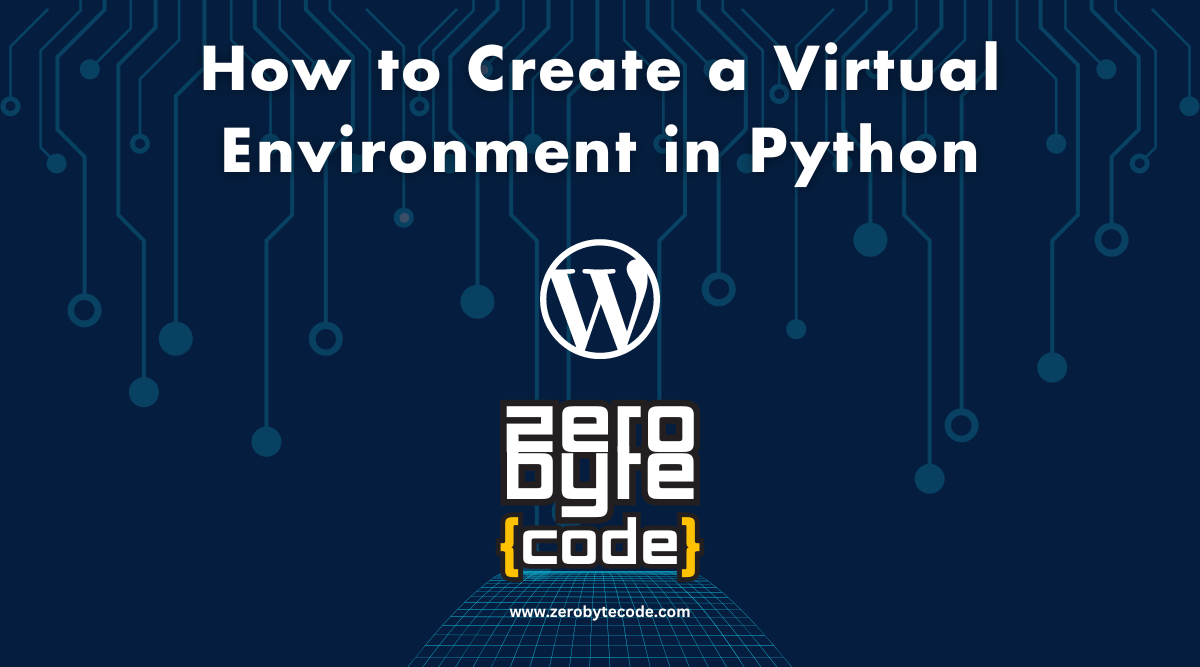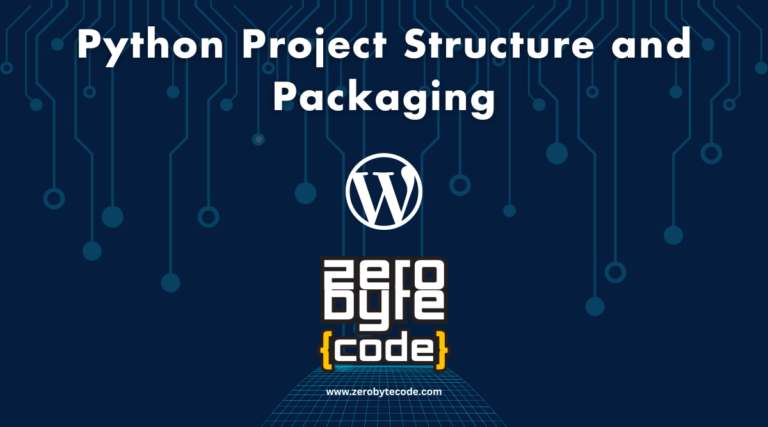How to Create a Virtual Environment in Python
How to Create a Virtual Environment in Python – Creating a virtual environment in Python is a fundamental skill that enhances project organization and dependency management.
- Understanding Virtual Environments in Python
- Step-by-Step Guide to Setting Up a Virtual Environment in Python
- Creating Your First Virtual Environment in Python
- Working with Multiple Virtual Environments
- Essential Tips for Python Virtual Environment Management
- General Best Practices for Python Virtual Environments
By establishing a dedicated space for your projects, you mitigate the risk of version conflicts and maintain a clean global environment. This process, while straightforward, involves several key steps that can greatly impact your workflow.
Highlights
Hide- Install the
virtualenvpackage usingpip install virtualenvto create isolated Python environments for your projects. - Use the built-in
venvmodule to create a virtual environment with a unique name and location for each project. - Activate the virtual environment using
source <env_name>/bin/activateon Unix or.\<env_name>\Scripts\activateon Windows. - Manage packages within the environment using
pip install package_nameand create arequirements.txtfile for easy installation later.
Understanding these nuances is essential for effective development. As we explore the specific methodology and best practices, you may discover approaches that could elevate your programming efficiency.
Understanding Virtual Environments in Python
A Python virtual environment is a self-contained directory that enables the isolation of project-specific dependencies, ensuring that different projects can coexist without interference.
Understanding its use cases is essential for effective project management, particularly in scenarios where multiple versions of libraries are required.
This section will explore the fundamental concepts of Python virtual environments and their practical applications.
What is a Python Virtual Environment?
A Python virtual environment is a self-contained directory that allows developers to manage project-specific dependencies in isolation.
This isolation is essential for preventing conflicts between package versions across different projects.
Understanding the necessity of creating virtual environments enhances the efficiency and organization of Python development workflows.
The Concept of Isolation in Python Virtual Environments
Isolation is a fundamental principle of Python virtual environments, allowing developers to create self-contained spaces for project dependencies without interference from the global Python environment.
This separation enhances project management and minimizes compatibility issues. Below is a comparison of isolated versus global environments:
| Feature | Isolated Environment | Global Environment |
|---|---|---|
| Dependency Control | High | Low |
| Conflict Resolution | Effective | Challenging |
| Environment Variability | Customizable | Static |
| Project-Specific | Yes | No |
Why Creating a Virtual Environment is Necessary
Creating a virtual environment in Python is necessary to assure that projects maintain their own dependencies and configurations, thereby preventing conflicts and promoting reproducibility.
This practice assures that each project can operate independently, minimizing the risk of version clashes between libraries.
The Use Cases of Virtual Environments in Python
Virtual environments in Python serve critical functions across various projects, primarily by isolating dependencies to prevent conflicts.
This isolation simplifies the management of different project requirements and facilitates easier cleanup and recovery processes.
Understanding these use cases enhances the effectiveness of development workflows and system maintenance.
Different Projects, Different Dependencies
Managing different projects often requires distinct sets of dependencies, making virtual environments an essential tool in Python development.
Utilizing virtual environments allows developers to:
- Isolate project-specific dependencies, preventing version conflicts.
- Streamline collaboration among team members by ensuring consistent environments.
- Simplify testing across various configurations, enhancing code reliability.
Embracing virtual environments fosters a more organized, efficient development process within the Python community.
Simplicity in System Cleanup and Recovery
The ability to easily clean up and recover systems is another significant advantage of utilizing virtual environments in Python development.
When a project becomes obsolete or requires updates, simply deleting the virtual environment eliminates all associated dependencies without affecting the global Python installation.
Also read: The Most Important Syntax and Strings in Python Programming
This streamlined process enhances efficiency and promotes a cleaner workspace, allowing developers to focus on innovation and collaboration within their teams.
Step-by-Step Guide to Setting Up a Virtual Environment in Python
Creating a virtual environment in Python is an essential practice for managing dependencies and maintaining project isolation. It allows you to work on multiple projects with different dependencies without conflicts.
In this guide, we’ll walk you through the process of setting up a virtual environment in Python.
What is a Virtual Environment?
A virtual environment is an isolated Python environment that allows you to install packages and dependencies specific to a project without affecting other projects or the global Python installation.
This isolation helps in managing dependencies, avoiding conflicts, and ensuring consistent project setups across different systems.
Step-by-Step Tutorial to Create a Virtual Environment in Python
We’ll cover creating and managing virtual environments on different operating systems, including Windows, macOS, and Linux.
Prerequisites
Before starting, ensure you have Python installed on your system. You can download Python from the official Python website.
Step 1: Installing Virtual Environment Tools
Python comes with a built-in module venv for creating virtual environments. However, if you’re using an older version of Python (before 3.3), you may need to install the virtualenv package.
Using venv (Python 3.3+)
The venv module is included by default in Python 3.3 and above, so no additional installation is required.
Using virtualenv (Python 2 or older Python 3 versions)
If you’re using an older version of Python, you can install virtualenv using pip:
pip install virtualenv
Step 2: Creating a Virtual Environment
You can create a virtual environment using venv or virtualenv. The process is similar for both tools, but venv is preferred for newer versions of Python.
Using venv
Navigate to your project directory in the terminal and run the following command:
# On Windows
python -m venv myenv
# On macOS/Linux
python3 -m venv myenv
Here, myenv is the name of the virtual environment. You can choose any name you prefer.
Using virtualenv
If you’re using virtualenv, the command is similar:
# On Windows
virtualenv myenv
# On macOS/Linux
virtualenv myenv
Step 3: Activating the Virtual Environment
After creating the virtual environment, you need to activate it to start using it. The activation process differs slightly depending on the operating system.
On Windows
myenv\Scripts\activate
On macOS/Linux
source myenv/bin/activate
Once activated, your terminal prompt will change to show the name of the active virtual environment, indicating that all Python commands will now use the virtual environment.
Step 4: Installing Packages
With the virtual environment activated, you can install packages using pip. These packages will be installed only in the virtual environment and won’t affect the global Python installation.
pip install package_name
For example, to install Flask, you would run:
pip install Flask
Step 5: Deactivating the Virtual Environment
When you’re done working in the virtual environment, you can deactivate it to return to the global Python environment.
deactivate
Step 6: Managing Dependencies with requirements.txt
It’s a good practice to keep track of the packages and their versions used in your project. This can be done using a requirements.txt file, which lists all the dependencies.
Creating requirements.txt
To create a requirements.txt file, run the following command with the virtual environment activated:
pip freeze > requirements.txt
This command saves the list of installed packages and their versions to requirements.txt.
Installing from requirements.txt
If you need to set up the same environment on another machine, you can install all the dependencies from requirements.txt using:
pip install -r requirements.txt
Step 7: Deleting a Virtual Environment
If you no longer need a virtual environment, you can delete it by simply removing the directory.
# On Windows
rmdir /s /q myenv
# On macOS/Linux
rm -rf myenv
Creating and using virtual environments is a best practice in Python development. It ensures that your projects have the necessary dependencies without conflicts and makes it easy to manage different projects on the same machine. By following this guide, you can set up and manage virtual environments effectively, leading to more organized and maintainable projects.
The role of Python in Virtual Environments
Creating a virtual environment in Python is essential for managing project dependencies and maintaining isolation between different software projects.
It allows developers to:
- Install packages without affecting the global Python installation.
- Test different package versions safely.
- Collaborate seamlessly with team members by ensuring consistent environments.
Utilizing virtual environments enhances productivity and fosters a shared understanding within development teams.
Recommended Python Versions for Creating Virtual Environments
Selecting the appropriate Python version is essential for successfully establishing a virtual environment, as it directly impacts compatibility with libraries and frameworks used in your projects.
Below is a table summarizing recommended Python versions for various use cases.
| Use Case | Recommended Python Version |
|---|---|
| Web Development | Python 3.8 or higher |
| Data Science | Python 3.7 or higher |
| Machine Learning | Python 3.8 or higher |
| Scripting | Python 3.6 or higher |
| Legacy Projects | Python 2.7 |
Installing the Virtual Environment Package in Python
To create a virtual environment in Python, the first step involves installing the Virtualenv package using Pip.
This process guarantees that developers can manage dependencies effectively in isolated environments.
After installation, it is essential to verify the successful setup of Virtualenv to confirm readiness for further configurations.
Using Pip to Install the Virtualenv Package
Installing the Virtualenv package using Pip is an essential step for setting up isolated Python environments.
Follow these steps to install Virtualenv:
- Open your command line interface (CLI).
- Execute the command `pip install virtualenv`.
- Confirm successful installation by checking the package list.
Verifying the Successful Installation of Virtualenv
Verifying the successful installation of Virtualenv verifies that the package is properly configured and ready for creating isolated Python environments.
To confirm installation, execute the command `virtualenv –version` in your terminal. If the version number appears, your installation is successful.
In case of an error, revisit the installation steps to verify all prerequisites are met, fostering a reliable Python development experience.
Creating Your First Virtual Environment in Python
Creating your first virtual environment in Python is an essential step in managing project dependencies effectively.
This process involves utilizing the built-in `venv` module to establish an isolated environment tailored for your project.
Once the environment is set up, you can proceed to install the necessary Python packages without affecting the global Python installation.
How to Create a Virtual Environment
Creating a virtual environment in Python begins with selecting an appropriate name and location for the environment, which is vital for organization and future reference.
Once established, activating the virtual environment is necessary to guarantee that dependencies and packages are isolated from the global Python installation.
This process sets the stage for effective project management and version control.
Choosing Your Environment Name and Location
When setting up a virtual environment in Python, selecting an appropriate name and location is essential for maintaining organization and ease of access.
Consider the following guidelines:
- Descriptive Names: Use meaningful names that reflect the project’s purpose.
- Consistent Structure: Create a consistent directory structure for all environments.
- Accessibility: Choose a location that is easily navigable for you and your team.
Activating Your Virtual Environment
Activating your virtual environment is the next step after establishing a well-organized name and location, allowing you to isolate project dependencies and manage packages effectively.
To activate, use the command `source <env_name>/bin/activate` on Unix or `.\<env_name>\Scripts\activate` on Windows.
Once activated, your terminal prompt will change, indicating that you are now working within your dedicated environment, fostering collaboration and consistency in your projects.
Installing Python Packages in Your Virtual Environment
Installing Python packages within your virtual environment is crucial for project-specific dependencies.
Utilizing Pip, the Python package installer, allows for straightforward package management, while requirements files facilitate the handling of multiple packages at once.
This process guarantees that your development environment remains clean and consistent across various projects.
Navigating Package Installation using Pip
Pip serves as the package manager for Python, enabling users to easily install and manage libraries within their virtual environments.
To effectively navigate package installation, consider the following:
- Use `pip install package_name` to install a library.
- Leverage `pip list` to view installed packages.
- Update packages with `pip install –upgrade package_name`.
These commands streamline your development process, fostering a collaborative programming environment.
Managing Multiple Packages with Requirements Files
To efficiently manage multiple packages in a Python project, utilizing a requirements file is essential for maintaining a clear and organized environment.
This file, typically named `requirements.txt`, lists all necessary packages along with their versions.
You can easily create it using pip freeze > requirements.txt.
To install these packages later, simply use `pip install -r requirements.txt`, ensuring consistency across environments.
Working with Multiple Virtual Environments
Managing multiple virtual environments is essential for maintaining separate dependencies across various projects.
This section will cover how to effectively handle different environments, including the processes for deactivating and deleting them when they are no longer needed.
Understanding these practices guarantees a streamlined workflow and minimizes conflicts between project requirements.
Handling Multiple Projects with Different Virtual Environments
Managing multiple projects in Python necessitates the use of distinct virtual environments to isolate dependencies and configurations.
This approach simplifies the process of switching between environments and guarantees that project-specific requirements do not conflict with one another.
Organizing workspaces by adhering to the principle of one project per environment enhances efficiency and reduces potential errors.
Switching Between Virtual Environments in Python
Switching between virtual environments in Python is essential for efficiently managing multiple projects that require different dependencies and configurations.
To seamlessly shift between environments, consider the following steps:
- Activate the desired environment using `source <env>/bin/activate` (Linux/Mac) or `<env>\Scripts\activate` (Windows).
- Verify the active environment with `which python` or `where python`.
- Deactivate using `deactivate` to return to the global environment.
Organizing Your Workspace: One Project, One Environment
Establishing a dedicated virtual environment for each project enhances dependency management and minimizes conflicts between differing libraries and versions.
This practice fosters a streamlined development process and allows for easy collaboration, ensuring that all team members work with the same configurations.
| Project Name | Virtual Environment Name |
|---|---|
| Project A | env_project_a |
| Project B | env_project_b |
| Project C | env_project_c |
Deactivating and Deleting Virtual Environments
Deactivating a virtual environment is essential to prevent conflicts between dependencies when switching between projects.
In addition, safely deleting a virtual environment guarantees that system resources are optimized and reduces clutter.
This section outlines the importance of deactivation and provides a step-by-step guide for proper deletion of virtual environments.
The Importance of Environment Deactivation
Regularly deactivating virtual environments is essential for maintaining system integrity and ensuring that dependencies do not conflict across different projects.
Key benefits include:
- Resource Management: Freeing up system resources by closing unused environments.
- Preventing Conflicts: Avoiding version clashes between projects.
- Streamlined Workflow: Enhancing focus on the active environment for better productivity.
Adopting these practices fosters a collaborative and efficient development ecosystem.
Steps for Safely Deleting a Virtual Environment
To safely delete a virtual environment, it is essential to first confirm that it is deactivated to avoid any unintended disruptions in your development workflow.
Use the command `deactivate` in your terminal.
Following deactivation, navigate to the directory containing the environment and execute `rm -rf <env_name>` on Unix-based systems or `rmdir /s <env_name>` on Windows.
This guarantees complete and secure removal.
Essential Tips for Python Virtual Environment Management
Effective management of Python virtual environments is vital for maintaining software integrity and efficiency.
This section will address key practices for keeping your environments up-to-date and outline common challenges encountered in virtual environment management, along with strategies to overcome them.
Keeping Your Virtual Environments Up-to-Date
Maintaining up-to-date virtual environments is essential for ensuring compatibility and leveraging the latest features and security patches.
Regularly upgrading packages within these environments helps mitigate vulnerabilities and enhances performance.
This section will outline effective strategies for upgrading packages and emphasize the importance of routine updates in virtual environment management.
How to Upgrade Packages in a Virtual Environment
Regularly upgrading packages in a virtual environment is essential for ensuring peak performance and security in Python development.
Follow these steps to effectively manage your upgrades:
- Activate your virtual environment using `source venv/bin/activate`.
- Use `pip list –outdated` to identify packages that need updating.
- Upgrade packages with `pip install –upgrade <package_name>`.
The Importance of Regularly Updating Virtual Environments
Updating virtual environments is essential for mitigating security vulnerabilities and ensuring compatibility with the latest features and improvements in Python packages.
Regular updates enhance performance and reduce conflicts. Below is a simple guide to manage your updates effectively:
| Action | Frequency |
|---|---|
| Check for updates | Monthly |
| Upgrade packages | Quarterly |
| Review dependencies | Biannually |
Common Challenges in Virtual Environment Management and How to Address Them
Managing virtual environments in Python presents common challenges, particularly with dependency conflicts and the potential for broken environments.
Addressing these issues requires a structured approach to maintain stability and functionality.
Implementing best practices can considerably mitigate these challenges and enhance overall management efficiency.
Dealing With Dependency Conflicts
Steering through dependency conflicts is a critical aspect of maintaining a stable Python virtual environment, as these conflicts can arise from incompatible package versions or overlapping dependencies.
To effectively manage these challenges, consider the following strategies:
- Utilize specific versioning in your requirements files.
- Regularly review and update dependencies.
- Leverage tools like `pip-tools` or `Poetry` for better resolution.
These practices foster a harmonious development experience.
Recovering From Broken Environments
Recovering from broken environments is essential for maintaining productivity and ensuring that development workflows remain uninterrupted.
To address issues, regularly back up your environment configurations, document installations, and maintain a requirements file. If an environment becomes unusable, recreate it using the backed-up configuration.
- How to Create a Simple Article Writing Tool with Python and OpenAI API
- How to Create a Simple URL Shortener Tool Using Python
- Introduction to Python for SEO: Automation and Data Analysis
- The Power of Python and Excel: A Beginner’s Guide to Data Automation
- Getting Started With Pandas for Data Analysis in Python
Additionally, utilize virtual environment tools such as `venv` or `conda` to streamline recovery processes and minimize downtime effectively.
General Best Practices for Python Virtual Environments
Establishing a robust set of best practices is essential for effective management of Python virtual environments.
This section will outline key do’s and don’ts to optimize environment usage, alongside strategies for enhancing security.
Implementing these guidelines will not only streamline development processes but also mitigate potential vulnerabilities.
The Do’s and Don’ts of Python Virtual Environs
Establishing best practices for Python virtual environments is essential for effective project management and dependency control.
This section will outline key conventions to follow and highlight common pitfalls that can undermine the integrity of virtual environments.
Following Python Virtual Environment Conventions
Following established conventions when creating Python virtual environments is essential for maintaining project organization and ensuring consistent dependency management.
Adhering to best practices can greatly enhance your development experience. Consider the following:
- Use meaningful names for your environments.
- Isolate project dependencies by creating a new environment for each project.
- Document your environment setup in a requirements file.
These practices foster collaboration and reduce conflicts.
Avoiding Common Pitfalls in Virtual Environment Management
Steering the management of Python virtual environments requires an awareness of common pitfalls to confirm efficient development and minimize issues related to dependency conflicts.
Always use version control for your environment files, avoid globally installing packages, and regularly update dependencies.
Additionally, maintain clear documentation of your environment setup to foster collaboration and confirm consistency across team members, enhancing overall project cohesion.
Securing Your Python Virtual Environments
Securing Python virtual environments is essential for maintaining the integrity and confidentiality of your projects.
Utilizing a .gitignore file effectively prevents sensitive files from being tracked in version control, thereby reducing the risk of exposure.
Additionally, safeguarding sensitive information within the environment is vital to protect against unauthorized access and data breaches.
The Role of the .gitignore File in Environment Security
The .gitignore file is an essential component in maintaining the security of Python virtual environments by preventing sensitive files and directories from being tracked in version control systems.
Key considerations include:
- Excluding Configuration Files: Prevent exposure of API keys and database credentials.
- Ignoring Temporary Files: Avoid cluttering repositories with unnecessary data.
- Securing Virtual Environment Directories: Keep environment dependencies private and secure.
Protecting Sensitive Information in Your Environment
Maintaining the integrity of sensitive information in Python virtual environments is essential, especially when considering the potential risks associated with version control systems.
To safeguard this information, utilize environment variables for configuration settings, avoid hardcoding secrets in source code, and implement access controls.
Regularly audit and update libraries to mitigate vulnerabilities, ensuring your development environment remains secure and compliant with best practices.







